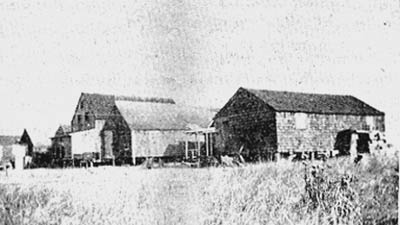Views and Reviews of Old Rockingham
By Rev. Roland D. Sawyer
The Hampton Union & Rockingham County Gazette, [Unknown date]

Our picture this week is of the most picturesque item along the coast, viz the Hampton Fish Houses.
In 1948 Frank E. Leavitt wrote off the following his story of these important buildings of an earlier day.
“The large one in the center of the group, with a chimney, was used many years by Randolph DeLancey. DeLancy bought it in 1872 from David I. Garland.
The one next on the North side belonged to Jonathan Godfrey, (Mr. Leavitt’s grandfather). It was built by Jonathan’s father, James Godfrey.
Next to it is a smaller one, built in recent years, or rather rebuilt, from an older one taken down which belonged to Alva and Levi Blake and was built by their father Moses Blake. Next stands a vacant spot, on which stood the Ames Fish House.
Mr. Perkins adds that when he was a boy there were houses taking up all the present vacant land North of the present last house.
Going south of the larger DeLancey house, the first was owned in 1948 by Lester Mace; his father owned it before him, and before that someone whose name I do not know.
South of Lester Mace is the old fish house once owned and used by Josiah and John Calvin Palmer.
Also toward the Coast Guard Station stands a house put up by two Palmers, though of recent date compared with the others, it was put up by George and Harry Palmer. This newer building was recently turned from its original use to be an elaborate camp.
Those of use who were boys, gathering about the group of old-time fish houses get a thrill when we pass them – what memories they recall.
Mr. Perkins is right, what memories they do recall. Memories of the 70 to 80 hardy men, who in days 60 or 70 years ago, were up early, rowed out in pairs or “fours”, got their early “catch”, which were thrown into covered section of the Hampton Whale-boat, and which came back to land around 2:30 p. m.
About the house would be standing a half dozen old horses, hitched to an old wagon, and each owner would buy what he thought he could sell, and then start forth.
They used to get up here to Kensington around 5 to 5:30, and the fish, mostly cod, sold for a quarter, unless they weighed over six pounds, then they brought 30 or 35 cents.
They came just in time for supper – and those cod reddish in color, from the deep cold water, had a flesh as hard as a piece of halibut. Many of them had been alive in water at noon or later, we were eating them at 5:30 or six.
I have never tasted anything in the fish line that equalled those fresh rock cod off Hampton shore, eaten with baked potatoes from the garden.
The little dry, thin filet of haddock, for which we today pay 70 to 80 cents a pound, is looked upon with scorn to those of us who have eaten the red cod unloaded from Hampton whaleboats, drawn up before the fish houses.
The old houses are not only picturesque and historic, but they remind us of the delights of living in Hampton or near it in those good old days.
[Editor’s note: Today (2007) there were only two left standing at North Beach, but not used for fishing.]